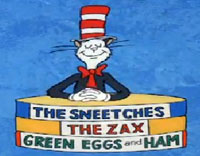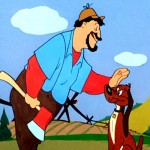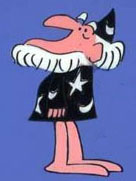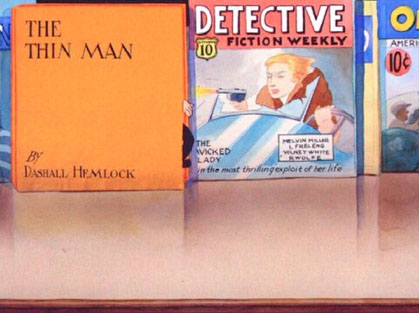 Seuss Specials. When asked how involved Ted Geisel (Dr. Seuss) was with the television specials done by DePatie-Freleng using his characters, David DePatie told Charles Brubaker in 2010, “He was a very hands-on guy. He lived down in La Jolla and he would fly over here. During the course of the production it wasn’t unusual to see him once a week. He was very instrumental in the creation of the series. Friz (Freleng) and I had a very good rapport with him. We enjoyed working with him and he enjoyed the studio and it was a far-cry from the bad experience he had with Chuck Jones on the earlier Christmas special. It was a very good relationship and everybody was pleased. I have sitting here in front of me three Emmys that we won for Dr. Seuss specials, with Friz and I as producers.”
Seuss Specials. When asked how involved Ted Geisel (Dr. Seuss) was with the television specials done by DePatie-Freleng using his characters, David DePatie told Charles Brubaker in 2010, “He was a very hands-on guy. He lived down in La Jolla and he would fly over here. During the course of the production it wasn’t unusual to see him once a week. He was very instrumental in the creation of the series. Friz (Freleng) and I had a very good rapport with him. We enjoyed working with him and he enjoyed the studio and it was a far-cry from the bad experience he had with Chuck Jones on the earlier Christmas special. It was a very good relationship and everybody was pleased. I have sitting here in front of me three Emmys that we won for Dr. Seuss specials, with Friz and I as producers.”
Disney Dinner. Jack Bradbury began working at Disney in 1934. Here is an excerpt from his unpublished autobiography about what it was like working there:
“A number of times when a (cartoon short) picture was nearing completion, we were asked to put in an evening of overtime. And though we did not get paid extra for this, everyone cooperated cheerfully.
“We were given a voucher for our evening’s work, one that bought us a 50 cent dinner at Leslie’s, a restaurant on Vermont just north of Hollywood Boulevard. At that time, believe it or not, Leslie’s served a good T-bone steak dinner for only 50 cents. We’d also have a glass of good California wine before dining and return to the studio full and happy, sometimes singing old Negro spirituals while we worked.”
 LumberJack Chuck. Chuck Jones in a 1975 interview with Greg Ford and Richard Thompson remembered: “I was called a ‘lumberjack’ by Disney people who thought I was a Communist. Well, they used to say that Communists took ‘little hairy Jewish people’ along when they had a speech to make at a union meeting. When I spoke at a meeting, one of the Disney animators said, ‘How come they’re using these big pink lumberjack types now?’ and pretty soon everybody was saying it. So I went home and took a look at myself. I was twenty-five and sure enough, I was a big pink lumberjack type. And I was a fat lumberjack—two hundred and five pounds.”
LumberJack Chuck. Chuck Jones in a 1975 interview with Greg Ford and Richard Thompson remembered: “I was called a ‘lumberjack’ by Disney people who thought I was a Communist. Well, they used to say that Communists took ‘little hairy Jewish people’ along when they had a speech to make at a union meeting. When I spoke at a meeting, one of the Disney animators said, ‘How come they’re using these big pink lumberjack types now?’ and pretty soon everybody was saying it. So I went home and took a look at myself. I was twenty-five and sure enough, I was a big pink lumberjack type. And I was a fat lumberjack—two hundred and five pounds.”
Why Not Less? During Who Framed Roger Rabbit (1988), director Richard Williams was pulled aside by Disney management and told that he was too much of a perfectionist and they weren’t going to let him do that on this picture. Williams responded that if he got 85% of what he wanted, he would be happy. Disney replied that on this film he could only get 35% to which Williams sarcastically responded, “Why not less?”
 Dead Dog. In the November 19, 1994 issue of TV Guide magazine, director Steven Spielberg was asked what happened to the animated television series Family Dog. “It was an experience I’d love to forget,” laughed the director. “Basically, we couldn’t afford to do the kind of shows we wanted and it deservedly bit the dust.”
Dead Dog. In the November 19, 1994 issue of TV Guide magazine, director Steven Spielberg was asked what happened to the animated television series Family Dog. “It was an experience I’d love to forget,” laughed the director. “Basically, we couldn’t afford to do the kind of shows we wanted and it deservedly bit the dust.”
Bad Popeye. Abdullah Al-Ateeqi wrote in the Kuwati paper Islamist Almujtama in 1995 that the animated Popeye cartoon sets a bad example for children because it “propagates the concept of abnormal friendships between men and women, since two men fight during the whole episode for the love of a woman”.
Ken Harris. Initially, animation legend Art Babbitt didn’t care for animator Ken Harris, dismissing him by saying “If he was any good, he would have been working at Disney’s”. However, Harris turned out so much footage for Richard Williams and it was so good that Babbitt had a hard time reconciling that thought with what he actually saw. By the way, Harris timed out Williams’ short film A Christmas Carol (1971) and when asked about it, he said he timed it like a Bugs Bunny cartoon.
 B.C. Animator Carl Bell was one of the animators on ABC-TV’s Curiosity Shop. In April 1972, he became associated with Levitow/Hanson Films as animator for Sesame Street segments and production manager for television commercials. In a 1973 interview, Bell talked about working on Johnny Hart’s B.C. comic strip characters: “B.C. is a very popular strip. There was a segment of B.C. in Curiosity Shop which Abe Levitow directed. Apparently, cartoonist Johnny Hart was satisfied with the working arrangement so Levitow/Hanson got the ‘Action’ spots using the B.C. characters and B.C. The First Thanksgiving (1973). Hart did the storyboards for Action and the special, and is in direct contact with the studio. Tony Rivera is doing layouts in the Hart manner. Hal Ambro and George Nicholas are keeping the animation consistent to the strip, very important when the public knows the characters so well that they can tell when the drawing goes off by a hair.”
B.C. Animator Carl Bell was one of the animators on ABC-TV’s Curiosity Shop. In April 1972, he became associated with Levitow/Hanson Films as animator for Sesame Street segments and production manager for television commercials. In a 1973 interview, Bell talked about working on Johnny Hart’s B.C. comic strip characters: “B.C. is a very popular strip. There was a segment of B.C. in Curiosity Shop which Abe Levitow directed. Apparently, cartoonist Johnny Hart was satisfied with the working arrangement so Levitow/Hanson got the ‘Action’ spots using the B.C. characters and B.C. The First Thanksgiving (1973). Hart did the storyboards for Action and the special, and is in direct contact with the studio. Tony Rivera is doing layouts in the Hart manner. Hal Ambro and George Nicholas are keeping the animation consistent to the strip, very important when the public knows the characters so well that they can tell when the drawing goes off by a hair.”
Making of The Incredibles Documentary. In the New York Post March 19, 2005, animator and director Brad Bird talked about why the “making of” documentary on “The Incredibles” (2004) was not a love fest: “My children have trophies for seasons where they tried really hard in sports and seasons where they didn’t. Which makes the trophies worthless. The nice, kind intention is that everyone will be happy every single moment of their life. But life isn’t that way. Life has disappointments and we can learn from them but not if every single fall is cushioned with a pillow.
“A lot of documentaries are shot afterwards, but ours (The Making of ‘The Incredibles’) was actually made while we were making the film. It’s not always a harmonious process. There are people with different feelings about what’s the best way to go. Conflicts arise and that’s a good thing to show. These films are a struggle to make. They don’t happen from people sitting around being happy. Making it look that way is like giving away meaningless trophies.”
What’s In a Name? It was not unusual for Warner Brothers to hide names of its artists in the background of cartoons but Speaking of the Weather (1937) offered a plethora of opportunities with its magazine stand setting to showcase everyone from Tubby Millar to Ray Katz. A copy of Mystery Magazine even headlines a story entitled “Vengence of the Inbetweeners”. However, Detective Fiction Weekly includes Melvin Millar, I. Freleng, (animator) Volney White and R. (Ralph) Wolfe.



 Jim Korkis is an internationally respected animation historian who in recent years has devoted his attention to the many worlds of Disney. He was a columnist for a variety of animation magazines. With his former writing partner, John Cawley, he authored several animation related books including The Encyclopedia of Cartoon Superstars, How to Create Animation, Cartoon Confidential and Get Animated’s Animation Art Buyer’s Guide. He taught animation classes at the Disney Institute in Florida as well as instructing classes on acting and animation history for Disney Feature Animation: Florida.
Jim Korkis is an internationally respected animation historian who in recent years has devoted his attention to the many worlds of Disney. He was a columnist for a variety of animation magazines. With his former writing partner, John Cawley, he authored several animation related books including The Encyclopedia of Cartoon Superstars, How to Create Animation, Cartoon Confidential and Get Animated’s Animation Art Buyer’s Guide. He taught animation classes at the Disney Institute in Florida as well as instructing classes on acting and animation history for Disney Feature Animation: Florida.




















































What do you suppose dePatie meant by the “bad experience” between Jones and Geisel? I know that Jones and Frank Tashlin had clashed over “The Bear That Wasn’t.” Is this a reference to the Grinch? Forgive the questions, since this is the first I’ve heard of a Jones-Geisel clash.
I don’t know the exact details that went on, but Jones and Seuss frequently clashed over the “Grinch” and “Horton” specials. Eventually, with Jones’s MGM studio shutting down, he took the opportunity to find a new studio, and decided to get in touch with DePatie-Freleng.
“The Cat in the Hat” was supposed to be the third special from Chuck Jones, but production moved early on to DFE. Jones had a storyboard all worked out, but Hawley Pratt, who took over directing, threw everything out and started over from scratch. In spite of that, Jones still got screen credit for storyboarding (as well as co-producing with Seuss).
I’ve never seen any references to static during “Grinch”, but Jones’s friction with Tashlin and Walt Kelly are well known. The heart of it seems to be that Jones puts too much of his own recognizable stamp on material by other artists, the way Disney did on the source material for his features. Did Hanna and/or Barbara even weigh in on the Jones version of Tom and Jerry?
One can only imagine what would have happened if Jones tried to work with Jules Feiffer on “The Phantom Tollbooth.”
That said, I remain a Jones fan. He’s at his best when not adapting anybody or going for sentiment.
The only complaint I’ve heard of Geisel making about HOW THE GRINCH STOLE CHRISTMAS (which is not to say he might not have had other complaints) was over Chuck Jones’s redesign of his characters. Geisel apparently thought that Jones’s “makeover” of the Grinch veered too close to making the character “cute.”
“The Cat in the Hat” was supposed to be the third special from Chuck Jones, but production moved early on to DFE. Jones had a storyboard all worked out, but Hawley Pratt, who took over directing, threw everything out and started over from scratch. In spite of that, Jones still got screen credit for storyboarding (as well as co-producing with Seuss).
Funny how he got his name in there in the end anyway (wonder if he even asked).
Geisel apparently thought that Jones’s “makeover” of the Grinch veered too close to making the character “cute.”
I remember he said that the Grinch in the film looked too much like Chuck Jones (who based the expressions on his own).
I’m a big fan of those Seuss specials, but I can only recall two of them winning Emmys: Halloween is Grinch Night (’77) and The Grinch Grinches the Cat in the Hat (’82). What was the third?
For what it’s worth, I always enjoyed DFE’s first three Seuss specials the best: The Cat in the Hat (’71), The Lorax (’72), and Dr. Seuss on the Loose (’73). They had such great songs in each!
Of the DPE Dr. Suess specials – one of my favorites was Halloween is Grinch Night which featured Hans Conreid (taking over as the Grinch who was previously voiced by Boris Karloff) who also starred in the Chuck Jones adaptation of Horton Hears a Who! – and with a awesome musical score by Joe Rasposo.
Other Dr Suess specials animated by DPE – such as The Lorax and the Green Eggs and Ham segment – had musical scores composed by Dean Elliot (who also scored many of the Tom & Jerry cartoons animated by Chuck Jones, The Phantom Tollbooth, Chuck Jones adaptation of Horton Hears a Who!, and Chuck Jones’s Jungle Book trilogy).
And on your anecdote about the so called “Popeye/Bluto-Brutus/Olive Oyl love triangle” – which was condemned by Kuwaiti newspaper reporter AbdullahAl-Ateeqi for the Kuwaiti newspaper Islamist Almutjama – about the quote “propagates the concept of abnormal friendships between men and women, since two men fight during the whole episode for the love of the women”. Not all Popeye cartoons were involved with the Popeye/Bluto/Olive Oyl love triangle (later the Popeye/Brutus/Olive Oyl in the 1960’s KFS Popeye cartoons and HB’s return of the Popeye/Bluto/Olive Oyl triangle in the late 1970’s) many involved Popeye in solo adventures, other with Bluto sans Olive Oyl and vice versa, his nephews Pipeye, Pupeye, Poopeye and Peepeye, not to mention Swee’Pea, Eugene the Jeep Poopdeck Pappy and Wimpy.
The most famous of the Popeye/Bluto/Olive Oyl cartoons was “It’s the Natural Thing To Do” where the trio got a letter from one of thier fan clubs to “tone down the violence and act refined” which ended in a comical free for all brawl.
The background gags continued into Tashlin’s “Have You Got Any Castles?”, where one of the books interestingly is “Guilds – Their Formation and Management” with the authors listed as “Darling in collaboration with Ted Pierce”. Given the building clashes over unionization in the animation industry by mid-1938, it would be interesting to know what Leon thought if he managed to spot that background when the cartoon was screened.
I do remember the PSA for ACTION (American Council To Improve Our Neighborhoods – a sort of urban Peace Corps) featuring the “B.C.” gang…they sang a jingle based on the song “A – You’re Adorable”:
“A is for Action Corps
C, we contribute more
T is for the teamwork of our crew,
I, our ideals are high
O, oughtn’t you apply
N, stands for now that we need you…”
The “Fat Broad” character was voiced by a guy singing falsetto; the Archeopteryx had a Donald Duck-ish voice, and got zapped by a lightning bolt at the end.
If Geisel disliked Jones’ design of the Grinch, what did he think of DFE’s “Halloween is Grinch Night”?
Don’t forget “The Grinch Grinches The Cat In The Hat”! That’s nearly scraping the bottom of the barrel!